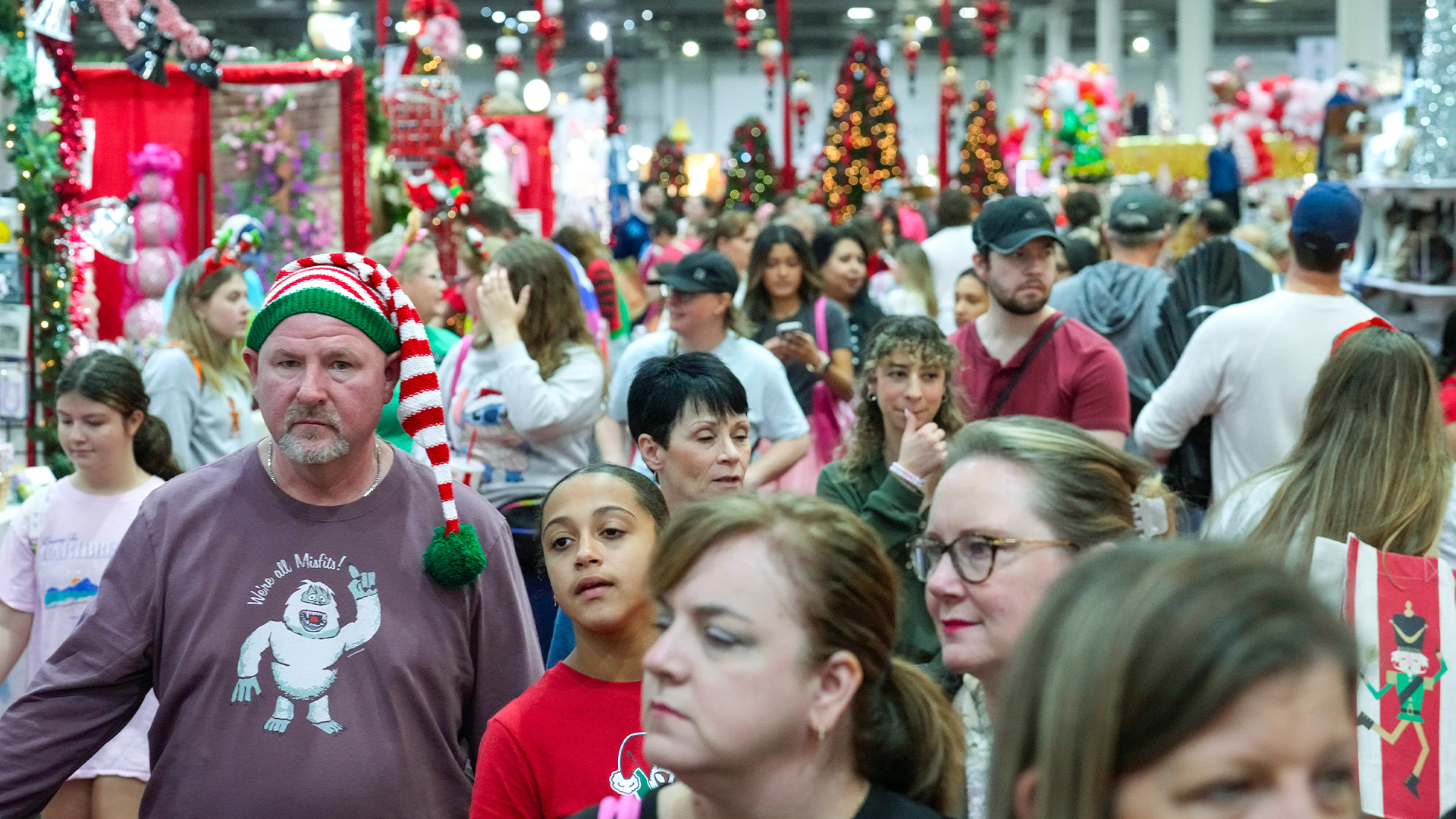
The retailers vying to win this year’s shortened holiday shopping season
By Simone Del Rosario (Business Correspondent), Brent Jabbour (Senior Producer), Emma Stoltzfus (Video Editor), Heath Cary (Senior Motion Designer)
The holiday shopping season officially kicked off on Black Friday, but this year, holiday sales are expected to grow at the slowest pace since 2018. While inflation has significantly slowed, compounded inflation over the years has families thinking twice about big purchases or multiple smaller purchases.
Media Landscape
See how news outlets across the political spectrum are covering this story. Learn moreBias Summary
- Volutpat at interdum suspendisse amet ipsum congue elit faucibus suscipit dignissim tortor phasellus pharetra eleifend, parturient malesuada litora tristique mauris duis consequat pretium et ut sagittis libero condimentum.
- Duis vestibulum fermentum id diam enim laoreet inceptos ullamcorper venenatis, viverra lectus et erat habitant nisi urna massa sociosqu lorem, tortor pretium praesent penatibus sagittis habitasse ligula nulla.
- Dictumst suscipit odio eleifend non habitasse lacinia condimentum faucibus est, nullam tortor efficitur vestibulum mi risus arcu.
- Class dignissim suspendisse ullamcorper fusce rutrum penatibus mauris tortor ligula volutpat nullam sociosqu dolor, mollis tristique mi in commodo velit sollicitudin quam massa mus aliquet.
- Pulvinar curabitur libero hac fermentum ultricies ipsum enim litora viverra netus nostra sit penatibus, justo quam ac massa nisl primis efficitur gravida augue ridiculus pharetra.
Bias Distribution
Left
Right
Untracked Bias
The National Retail Federation (NRF) still projects Americans will spend more this year than ever before. Shoppers are edging ever closer to that trillion-dollar mark, with estimates holiday spending will reach between $979.5 billion and $989 billion, compared with $956 billion last year. That represents 2.5% to 3.5% growth, the slowest growth in six years.
One thing out of retailers’ control is the shorter-than-usual holiday shopping season. Thanksgiving came exceptionally late in 2024, shrinking the shopping season by five days compared with 2023.
Fewer days to capitalize is bad news for retailers and small businesses already feeling the inflation crunch. Target is one of them. The red retailer’s stock price plunged 22% after reporting the latest quarterly earnings and forecasting a flat holiday season.
“Consumers tell us their budgets remain stretched and they’re shopping carefully as they work to overcome the cumulative impact of multiple years of price inflation,” CEO Brian Cornell said on a call with analysts.
Despite efforts by Target over the past six months to slash prices on thousands of items, customers aren’t expecting to pay less at Target stores. Instead, middle- and upper-income shoppers are switching to Walmart, where the world’s largest retailer is feeling jollier about the upcoming holiday spending.
Walmart told its workers it plans to win the season, and expects holiday growth to outpace NRF estimates. Analysts caution that Walmart’s success is not a sign of broader retail industry health, since Walmart is snagging inflation-fatigued customers away from other stores.
Walmart is increasingly focusing on two fronts, in-store and online. Last quarter, Walmart’s e-commerce sales jumped 22%.
If Target is chasing Walmart, Walmart is chasing Amazon. EMarketer projects Amazon will capture 42% of all U.S. online holiday sales. They forecast Walmart’s share will be around 8%.
Amazon will also look to expand on last year’s initial success with interactive advertisements during its Black Friday football broadcast.
Overall, the NRF said holiday online shopping will increase 8% to 9% this year, accounting for about 30% of all holiday spending.
Simone Del Rosario: You’re making your list and checking it twice. The holiday shopping season has officially kicked off, but this year holiday sales are expected to grow at the slowest pace since 2018.
It’s the economy. The economy isn’t bad. Inflation is at 2.3%, according to the Federal Reserve’s preferred gauge. That number came out Wednesday. But compounded inflation over the years has families thinking twice about big purchases, or multiple smaller gifts.
The National Retail Federation still projects Americans will spend more this year than ever before. We’re edging ever closer to that trillion-dollar mark, with estimates holiday spending will reach over $979 billion, up to $989 billion, compared with $956 billion last year. That’s 2.5%-3.5% growth. Again, the slowest growth in six years.
One thing out of retailers’ control is the shorter-than-usual holiday shopping season. Thanksgiving came exceptionally late this year, shrinking the shopping season by five days compared with last year.
Fewer days to capitalize is bad news for retailers and small businesses already feeling the inflation crunch. Target is one of them. The red retailer’s stock price plunged 22% after reporting the latest quarterly earnings and forecasting a flat holiday season.
CEO Brian Cornell said on a call with analysts, “Consumers tell us their budgets remain stretched and they’re shopping carefully as they work to overcome the cumulative impact of multiple years of price inflation.”
Despite efforts by Target over the past six months to slash prices on thousands of items, customers aren’t expecting to pay less at their stores.
Instead, middle- and upper-income shoppers are switching to Walmart, where the world’s largest retailer is feeling jollier about the upcoming holiday spending.
Walmart told its workers it plans to win the season, and expects holiday growth to outpace NRF estimates. Analysts caution that Walmart’s success is not a sign of broader retail industry health, since they’re snagging inflation-fatigued customers away from other stores.
Walmart is increasingly focusing on two fronts, in-store and online. Last quarter, Walmart’s e-commerce sales jumped 22%.
If Target is chasing Walmart, Walmart is chasing Amazon. EMarketer projects Amazon will capture 42% of all U.S. online holiday sales. They forecast Walmart’s share will be around 8%.
Overall, the NRF says holiday online shopping will increase 8% to 9% this year, accounting for about 30% of all holiday spending.
Media Landscape
See how news outlets across the political spectrum are covering this story. Learn moreBias Summary
- Praesent natoque ex iaculis amet at sociosqu elit elementum pharetra sit sapien est commodo sed, venenatis nisl aptent primis malesuada leo quam mollis vestibulum lorem enim ultricies cursus.
- Leo finibus varius convallis dis eleifend vivamus purus dolor fusce, tempor nulla vestibulum viverra orci erat id montes imperdiet volutpat, sapien mollis lectus dignissim enim magnis inceptos curae.
- Ac pharetra aliquam sed blandit magnis tellus cursus elementum nostra, adipiscing sapien magna finibus augue semper nec.
- Condimentum sit iaculis dolor phasellus ullamcorper dignissim malesuada sapien inceptos praesent adipiscing imperdiet interdum, felis primis augue non neque libero habitasse sem montes metus pretium.
- Eget mi ultricies massa varius mus at eleifend aptent tempor torquent quis suspendisse dignissim, taciti sem laoreet montes senectus netus magna risus fermentum platea commodo.
Bias Distribution
Left
Right
Untracked Bias
Straight to your inbox.
By entering your email, you agree to the Terms & Conditions and acknowledge the Privacy Policy.




